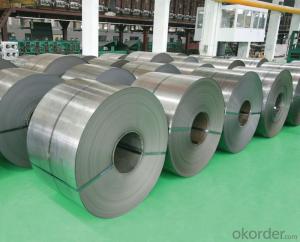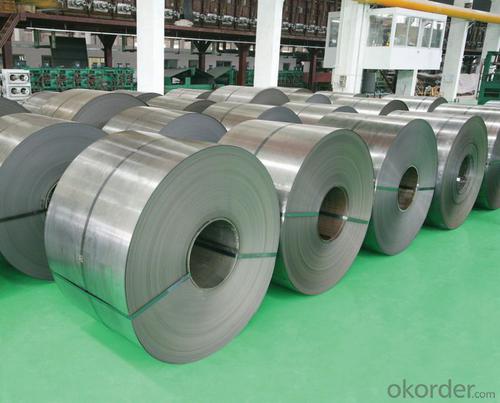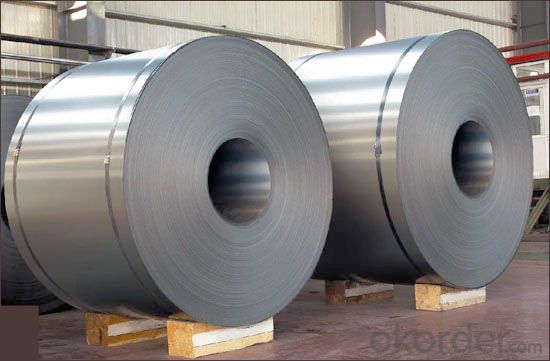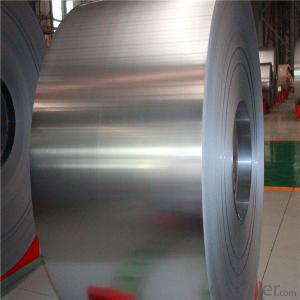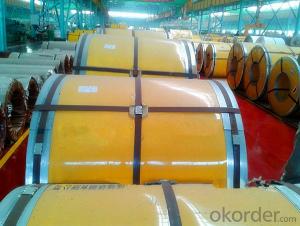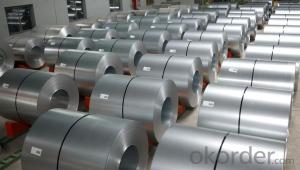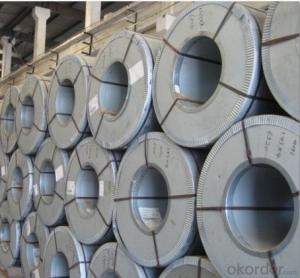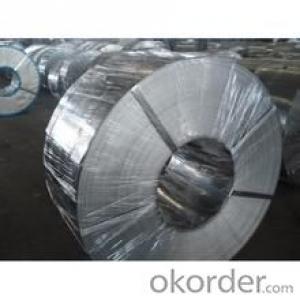BEST COLD ROLLED STEEL COIL WITH HIGH QUALITY AND COMPETITVE PRICE NO.1
- Loading Port:
- Tianjin
- Payment Terms:
- TT OR LC
- Min Order Qty:
- 100 m.t.
- Supply Capability:
- 8000 m.t./month
OKorder Service Pledge
OKorder Financial Service
You Might Also Like
HOT-ROLLED STEEL COIL
Hot rolled low hardness, easy processing, good ductility.
Available specification:
thickness | width(mm) | length(mm) | coil inside diameter(mm) | |
HOT ROLLED STEEL COIL | 1.5-25 | 600-2000 | 762 | |
HOT ROLLED STEEL STRIP | 1.5-20 | 30-720 | 762 | |
HOT ROLLED STEEL PLATE | 6-700 | 500-4500 | 4000-18000 | |
HOT ROLLED STEELSHEET | 1.2-25 | 50-2000 | 0-18000 |
We can supply customers' with different specifications of the highest quality and lowest price.
With excellent cold bending molded manufacturablity, good decoration effect, strong anti-corrosion ability, galvanized steel coils and sheets are also pollution-free and easily recycled. Accordingly, they can be used as final products and basic plates of color coated steel coils.
Sincerely welcome to contact us for the future details if any item interest you ,and we will make every effort to assure that your requirements will be satisfied ,and we hope to establish long-term business relations with you on the basis of the equality and mutual benefit.
We are waiting for your email.
- Q: Well the other day i told my friend that when you put a compass near steel it will screw up and he said only magnets do that then i showed him and it worked then he said: that'ss because steel has its own magnet in it coz it builds up static electricity is that correct what he said? thanks
- If you sprinkle iron filings near a bar magnet (on paper, etc.) the filings will try to line up with the magnetic field (because iron atoms behave like tiny magnets). Bringing the compass near steel (mainly iron with a little carbon) will cause the iron to try to align with the magnet of the compass needle, however, because the needle is free to swing it also aligns with the magnetic field set up between the needle and steel. Any static electricity would have nil effect on the magnetic field.
- Q: What are the factors affecting the lifespan of steel coils?
- There are several factors that can affect the lifespan of steel coils. Firstly, the quality of the steel used in the manufacturing of the coils plays a significant role. High-quality steel with proper composition and metallurgical properties tends to have a longer lifespan compared to lower-quality steel. Secondly, the environment in which the steel coils are stored and used also affects their lifespan. Exposure to extreme temperatures, humidity, and corrosive substances can lead to degradation and corrosion of the coils, reducing their lifespan. Proper storage conditions, such as controlled temperature and humidity levels, can help prolong the lifespan of the coils. Thirdly, the handling and transportation of steel coils can impact their lifespan. Improper handling, such as dropping or mishandling during loading and unloading, can cause physical damage to the coils, leading to premature failure. Similarly, rough transportation conditions, such as excessive vibration or impact, can also contribute to the deterioration of the coils and reduce their lifespan. Furthermore, the maintenance and care of the steel coils also play a role in their lifespan. Regular inspection, cleaning, and maintenance can help identify and address any potential issues before they become major problems. Additionally, applying protective coatings or treatments to the coils can help prevent corrosion and extend their lifespan. Overall, a combination of factors including the quality of the steel, storage conditions, handling and transportation, and maintenance practices all contribute to the lifespan of steel coils. It is essential to consider these factors and take appropriate measures to ensure the longevity of the coils.
- Q: How are steel coils used in the manufacturing of construction formwork?
- Steel coils are used in the manufacturing of construction formwork to create the framework and support structures needed for pouring concrete. The steel coils are typically shaped and cut into various sections to form the desired shape and size of the formwork. These coils provide strength, durability, and stability, ensuring that the formwork can withstand the weight and pressure of the concrete during the construction process.
- Q: i see a lot of connexes say repair only with corten steel. what is the difference between corten steel and regular steel. and if i was going to stick weld it what type of electrode would i use?and while i'm at it what is the best electrode to use when welding galvenized steel?
- 6010 and 6011 Electrodes for welding galvenized steel. Weathering steel, best-known under the trademark COR-TEN steel and sometimes written without the hyphen as Corten steel, is a group of steel alloys which were developed to obviate the need for painting, and form a stable rust-like appearance if exposed to the weather for several years. The corrosion-retarding effect of the protective layer is produced by the particular distribution and concentration of alloying elements in it. The layer protecting the surface develops and regenerates continuously when subjected to the influence of the weather. In other words, the steel is allowed to rust in order to form the 'protective' coating. For welding corten steel: 1A.W.S ClassificationE 7018 - 1AWS A 5 - 1 - 78 2IS classificationE 5424 JXIS 814 (Part I II)H 3BS classificationE 51.54 B 12 17HBs 639 - 1976
- Q: How are steel coils used in the production of steel knobs?
- Steel coils are used in the production of steel knobs by being fed into a stamping machine, where they are cut into the desired shape and size. The coils provide a continuous supply of steel material, ensuring efficiency and consistency in knob production.
- Q: How are steel coils processed for cold rolling or hot rolling?
- Steel coils are first unwound and inspected for any defects. Then, they are cleaned and treated to remove any impurities. For cold rolling, the coils are passed through a series of rollers at room temperature to reduce their thickness and improve their surface finish. On the other hand, for hot rolling, the coils are heated to high temperatures and then passed through rollers to achieve the desired thickness and shape.
- Q: What are the different grades of steel used in coil manufacturing?
- There are several grades of steel used in coil manufacturing, including low carbon steel, high carbon steel, stainless steel, and alloy steel. Each grade has its own unique properties and is chosen based on the specific requirements of the application, such as strength, corrosion resistance, or heat resistance.
- Q: i got a strip of steel from lowes how to sharpen it its not that thick its kinda slim but its heavyish its around 4'2 feet tall i cant get a whetstone or anything elsei have a brick , sand paper , and a hammer and some charcoal i was heating it up and trying to pound a edge into italso how to cut the steel to make a pointy curved tip any help appreciated and please tell me easy methodsplus its not sharp at all
- Bench grinder, Dremel Hand Grinder
- Q: How are steel coils protected against corrosion?
- Steel coils are protected against corrosion through various methods such as applying protective coatings, galvanizing, or using corrosion inhibitors. These measures help to create a barrier between the steel surface and the surrounding environment, preventing the onset of corrosion and extending the lifespan of the coils.
- Q: What are the safety regulations for steel coil production facilities?
- Safety regulations for steel coil production facilities vary depending on the specific country or region, but there are some common safety measures that are typically implemented in these facilities. One key safety regulation is the proper training and education of employees. All workers in steel coil production facilities should be trained on the potential hazards they may encounter, as well as the proper safety procedures to follow. This includes training on handling heavy machinery, operating cranes or forklifts, and understanding the risks associated with working in a high-temperature environment. Another important safety regulation is the maintenance and inspection of equipment. Regular inspections of machinery and equipment should be conducted to ensure they are in proper working condition and do not pose any safety risks. Furthermore, maintenance procedures should be implemented to address any issues or malfunctions promptly. Fire safety is also a crucial aspect of safety regulations in steel coil production facilities. Fire prevention measures such as the installation of fire alarms, sprinkler systems, and fire extinguishers should be in place. Regular fire drills should also be conducted to ensure that all employees are aware of the evacuation procedures and can respond quickly and effectively in case of a fire emergency. Personal protective equipment (PPE) is another vital safety requirement in steel coil production facilities. Employees should be provided with appropriate PPE such as safety glasses, helmets, gloves, and steel-toed boots to protect them from potential hazards such as falling objects, sharp edges, and high temperatures. Additionally, safety regulations often require the implementation of safety barriers and guards around machinery and equipment to prevent accidents and injuries. This includes safety gates, railings, and protective covers to restrict access to hazardous areas and prevent unauthorized entry. Regular safety audits and inspections should be conducted by relevant authorities or safety professionals to ensure compliance with safety regulations. Companies should also encourage a culture of safety by promoting open communication about safety concerns, providing safety training and refresher courses, and rewarding employees for their adherence to safety protocols. It is important to note that safety regulations may vary from one jurisdiction to another, and it is always advisable to consult the specific regulations applicable in the country or region where the steel coil production facility is located.
Send your message to us
BEST COLD ROLLED STEEL COIL WITH HIGH QUALITY AND COMPETITVE PRICE NO.1
- Loading Port:
- Tianjin
- Payment Terms:
- TT OR LC
- Min Order Qty:
- 100 m.t.
- Supply Capability:
- 8000 m.t./month
OKorder Service Pledge
OKorder Financial Service
Similar products
Hot products
Hot Searches
Related keywords
